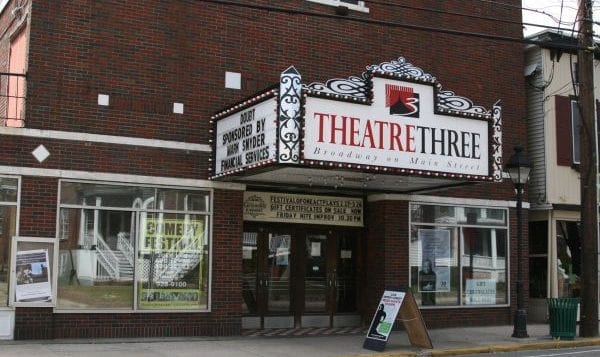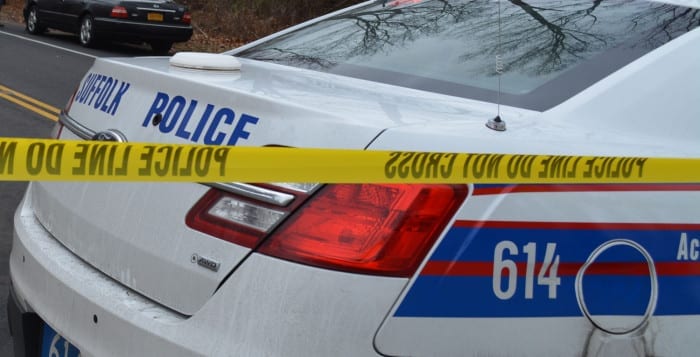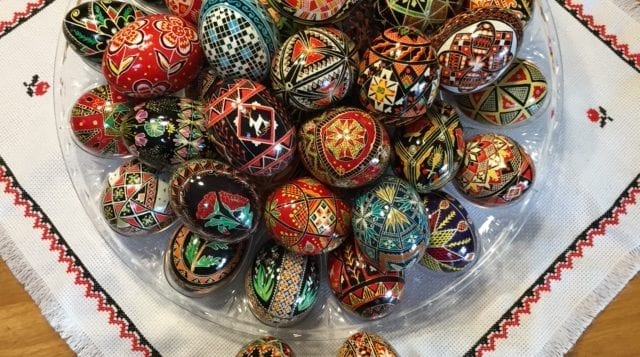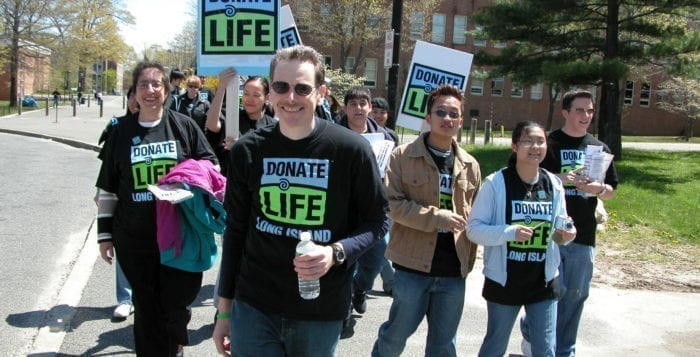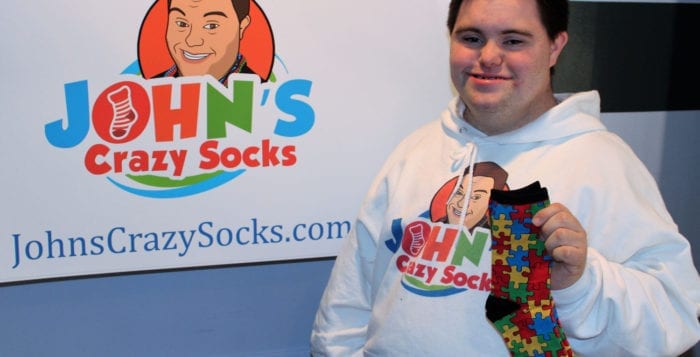The Brick Studio and Gallery at Rocky Point invites the community for a free screening of Charlie Chaplin’s masterpiece, “Modern Times,” at the VFW Hall, 109 King Road, Rocky Point on Monday, March 6 at 7 p.m. Stay after the movie, enjoy light refreshments and learn about special events and art exhibitions that will happen when the Brick Studio and Gallery opens its doors. For info, call 631-335-2293 or visit www.thebrickstudio.org.
Yearly Archives: 2017
Open cast call at Theatre Three
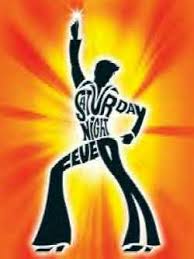 Theatre Three, 412 Main St., Port Jefferson is seeking singer-actor-dancers (ages 16 and up; must appear 19 or older) for various roles in its upcoming Mainstage production of “Saturday Night Fever: The Musical.” Open auditions will be held on Saturday, March 4 at 3 p.m.
Theatre Three, 412 Main St., Port Jefferson is seeking singer-actor-dancers (ages 16 and up; must appear 19 or older) for various roles in its upcoming Mainstage production of “Saturday Night Fever: The Musical.” Open auditions will be held on Saturday, March 4 at 3 p.m.
Prepare 16 bars from the song of your choice; bring sheet music in the proper key; accompanist provided. You may sing from the score. Be prepared to dance. Readings will be from the script. Please bring picture/resume. Rehearsals to begin in April. Performances will take place from May 20 to June 24.
For full details, call 631-928-9202 or visit www.theatrethree.com/auditions.html.
Rocky Point man seriously injured in Port Jeff Station crash
A Rocky Point man was ejected from his vehicle as a result of a crash in Port Jefferson Station Feb. 22 and transported to Stony Brook Hospital for treatment of serious injuries, according to Suffolk County Police. Sixth Squad detectives are investigating the two-vehicle crash.
Brian Carter was driving a 1975 Jeep westbound on Route 347 when he attempted to make a left turn onto Crystal Brook Hollow Road and his vehicle was struck by an eastbound 2009 Chevrolet at about 8:20 p.m.
Carter, 25, of Rocky Point, was ejected from the vehicle and was transported to Stony Brook University Hospital for treatment of serious injuries. The driver of the Chevrolet, Zachary Pisoni, 24, of Medford, was not injured.
Both vehicles were impounded for safety checks and the investigation is continuing. Detectives are asking anyone with information on this crash to call the 6th Squad at 631-854-8652.
Egg Pysanky Workshop offered in Smithtown
Resurrection Byzantine Church, located at the corner of Mayflower and Edgewater Avenues in Smithtown, invites the community to take part in its 6th annual Traditional Ukrainian Easter Egg (Pysanky) workshop on March 26 and April 2 from 1 to 3 p.m.
The two-day workshop, which will take place in the church’s Social Hall, is open to all levels of experience. Learn and complete your first egg, discover new patterns and tips or show your skills and enjoy the company. Bring your dyes and tools or start fresh with a new kit, available for an additional $15. Each participant must bring a candle in a holder, pencils and a roll of paper towels.
Two-day class fee is $20. Deadline to register is March 6. For more information or to sign up, call Joanne at 631-332-1449 or email [email protected].
Long Island’s history comes alive
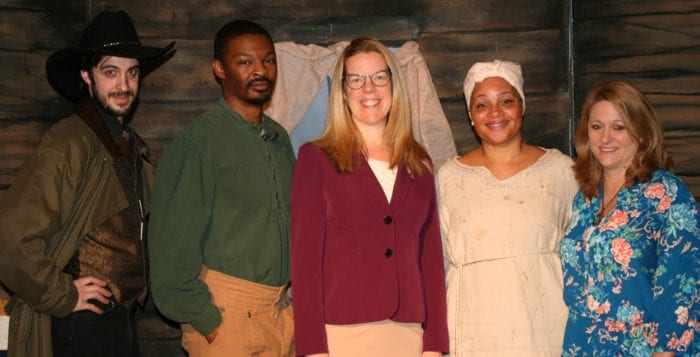
Suffolk County Legislator Kara Hahn (D-Setauket) and Empire National Bank are this year’s generous sponsors of Ward Melville Heritage Organization’s riveting live theatrical drama, “Running Scared, Running Free … Escape to the Promised Land.” Performed by St. George Living History Productions, it tells the story of slaves escaping through the Underground Railroad from the south to Long Island and north to Canada. Native Americans, Quakers, free blacks and Abolitionists assisted them through the fascinating use of secret codes in quilt patterns as a means of communication.
The show, currently in production at the WMHO’s Educational & Cultural Center, 97P Main St., Stony Brook runs through Feb. 28. Tickets, by reservation, are $12 per adult; $12 per student (up to 35 students); $8 per student (over 35 students). To order, call 631-689-5888. For further information on this and other WMHO educational programming, call 631-751-2244 or visit www.wmho.org.
State lowers organ donor registration age
By Kevin Redding
As of Feb. 14, National Organ Donor Day, a new state law rolled out by Gov. Andrew Cuomo (D) permits 16- and 17-year-olds to enroll in the New York State Donate Life Registry when they apply for a driver’s license, learner’s permit or nondriver ID, potentially growing enrollments in New York by thousands.
Sponsored by State Sens. John Flanagan (R-East Northport) and Kemp Hannon (R-Garden City), the legislation’s altered minimum age to sign up as an organ donor, which had previously been 18, serves as a big step for New York, which currently ranks 50th out of all 50 states when it comes to the percentage of residents enrolled to be organ donors.
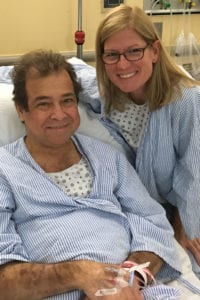
Town Councilwoman Jane Bonner. Photo from Councilwoman Bonner
At just 28 percent, New York State is “way at the bottom of the pack” when it comes to enrollment, according to Flanagan, a strong advocate for organ donations because of his late friend, Assemblyman James Conte (R-Huntington Station), who was the recipient of two kidney transplants before losing a battle with cancer in 2012.
“[New York] has been a leader in many ways on a wide variety of issues and we should be the premiere state in terms of organ donation,” Flanagan said. “I just want to promote organ donation, and promote awareness. There are thousands and thousands of people who are waiting for transplants here in the state, kidney being the primary one. We don’t have enough people signing up, and it’s taken too long to [get here] but I think we’re moving in the right direction.”
The senator said Conte is the reason he’s a donor, and after his death, he realized he could use his own political platform to advocate for this cause and encourage others to get involved.
Like Flanagan, Brookhaven Town Councilwoman Jane Bonner (C-Rocky Point) is passionate about organ donation and takes every opportunity to raise awareness about the importance of becoming a donor when speaking publicly, regardless of the event.
“I could be at a civic event talking about town improvement projects or town issues, and I always use it as a soapbox to talk about organ donation,” Bonner said. “Roughly 125,000 people in the United States are waiting for a kidney and there are 350 million people in the United States, seemingly with healthy kidneys. If everybody who could donate, donated one, we wouldn’t have people waiting for a kidney anymore and lives can be saved.”
Bonner said that under the new law, 16- and 17-year-olds can make donations upon their death, and it includes safeguards where their parents or legal guardians have the option to rescind the decision if the minor dies before 18.
“It not only ups the amount of eligible organ donors there are to sign up and save lives, but also starts a conversation at an earlier age about its importance.”
— Megan Fackler
“Teenagers are very passionate about so many issues and I think this legislation was made because they’re employing every toy in the toolbox, knowing the state is dead last,” she said.
The councilwoman knows a thing or two about saving lives this way.
It was last April when Bonner donated her kidney to her childhood friend Tom D’Antonio, who had been diagnosed with diabetes at a young age, had suffered multiple health issues over the years and desperately needed a transplant.
“I said ‘I’ll do it, we’re the same blood type,’ and I donated blood to him when he got his first kidney transplant,” Bonner recalled.
D’Antonio was more than grateful for the donation his longtime friend made.
“I bounced back like a rockstar and I feel great, I have more energy and determination,” D’Antonio said, reflecting on the experience. “It’s my belief that there is something within a human being that takes that step and makes that heroic move to save a life; it moves me beyond a place I can easily describe. Not only did [Jane] save my life but she enriched the lives of those close to me, [like my wife].”
But D’Antonio is not a big fan of the new law, calling it “hugely irresponsible” and a “grossly inadequate response” to appease a need for more donors.
“Sixteen- and seventeen-year-olds have enough trouble making a decision about what classes to take as seniors, their minds are still developing, and I’m appalled that this is the state’s answer,” he said. “What the state should do instead is put some money and effort into organ donor awareness and make it part of the teaching curriculum in high school.”

Alternatively, Kelli Cutinella, whose son Tom died October 2014 following a head-on collision during a high school football game, spoke in Albany to help get the law passed, and said she’s glad to see it in effect.
Tom, who wanted to register when he was 16 at the DMV but was ultimately not allowed at the time, donated all vital organs, such as his heart, kidneys, liver, pancreas, bones and skin.
“He was a giver in life and would do anything for anybody, and it didn’t surprise me that he wanted to register at 16, it was just in his nature,” Cutinella said.
The mother, who has an ongoing relationship with Tom’s heart recipient and pancreas and kidney recipient, was recently notified by a New York Burn Center that a 30-year-old man from Brooklyn had received Tom’s skin after suffering severe burns in a house fire.
“Tom lives on now,” Cutinella said. “He’s not here in the physical sense, but he is with the recipients as they go on to live wonderful, fulfilling lives.”
According to Megan Fackler of LiveOnNY, a federally designated organ procurement organization, the new law is exciting.
“It not only ups the amount of eligible organ donors there are to sign up and save lives, but also starts a conversation at an earlier age about its importance,” Fackler said. “Donor family and recipient meetings have been the most touching. There are lots of things 16- and 17-year-olds can’t do, like rent a car, get a tattoo, vote, join the army, but they can save lives.”
Residents can visit the New York State Health Department’s website at www.health.ny.gov/donatelife to get more information about organ donation in New York State, including how to register as a donor.
H’ton resident with Down syndrome starts sock company
By Victoria Espinoza
For one father-son duo, the secret ingredient to success is socks. John Cronin, a 21-year-old Huntington resident diagnosed with Down syndrome, was trying to figure out what he wanted to do with his life after he graduated from Huntington High School, when John’s Crazy Socks was born.
The two-month-old business venture has already seen success, and Cronin and his dad Mark Cronin are continually coming up with new and unique ideas to set John’s Crazy Socks apart.
“We opened the store Dec. 9 and expected a trickle of sales,” Mark Cronin said in a phone interview. “Instead we were flooded with sales. It turns out John is a social media star.”
The co-founders shot and uploaded a variety of videos to the company’s Facebook page, starring the 21-year-old who has become the face of the business.
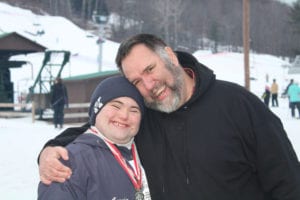
“Those first couple of videos we put up, which were spur of the moment, had 30,00 views,” the elder business partner said. “People were spreading them all around Huntington. So people flooded us and in fact on our first weekend we ran out of inventory.”
John’s Crazy Socks now ships nationally and internationally, and for local residents shipping may be the most enjoyable part of ordering from the company. Cronin hand-delivers local orders, which his dad said is an extra treat for customers.
“Word spread through social media that John would show up to a house to do a delivery, and whole families would come out to greet him and take photos,” he said.
Cronin said it’s one of his favorite parts of the business.
“I really like going to do home deliveries,” he said in a phone interview.
Aside from a friendly face with a new order of socks, patrons also receive a hand-written thank you note from Cronin as well as some Hershey kisses.
“We’ve learned a lot and saw there is a real opportunity here,” his father said. “We’re spreading happiness through socks, and it’s a way of connecting with people. The more people we can make happy the better off we will be.”
The team also gives customers two coupons with each purchase.
“We want to make it a great experience for people to buy from us,” Cronin’s father said.
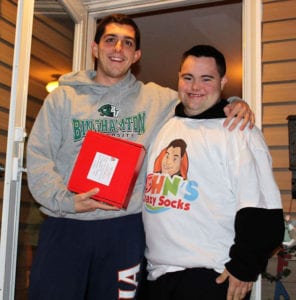
He said the duo has high hopes for John’s Crazy Socks, as they intend to become the world’s largest sock store, offering more sock styles and designs than anyone else. When the company started in December, they offered 31 different styles of socks. Today they offer more than 550 different styles.
It’s not just different colors and concepts customers can find at John’s Crazy Socks. They also sell socks with meaning behind them. Cronin designed an autism awareness and a Down syndrome awareness sock, as well as a breast cancer sock, and a Special Olympics sock. Cronin’s father said a portion of the proceeds from each specialized sock goes to national and local charity groups working towards finding a cure or to advocating for the groups, depending on the cause.
A blue whale sock was created for the Cold Spring Harbor Whaling Museum, and there are many other personalized socks to come.
For Cronin, socks represent self-expression.
“I really like socks,” he said. ‘They’re fun and they can fit your own personality.”
The elder Cronin said he’s enjoyed many aspects of starting the business with his son.
“I love bringing joy to people, the little things we get to do to just wow people,” he said. “We live in this increasingly complex world, and we can connect with people and say we hear you and we can make you happy, and that’s awesome. And it’s great to be able to do something with my son.”
Fake news and readership clues
Fake news is in the spotlight. Websites, blogs and social media are populated with it and even print can be. The goal of its perpetrators is to misinform and to destroy readers’ trust in what they read. This calls into question the real work of traditional journalists doing their jobs. Disinformation campaigns make all news suspect: What’s real and what’s fake? How can a free press properly be the watchdog of the people, the fourth estate of our democracy, if readers can’t believe what they read?
In an effort to sort out the real from the fake, especially in advance of key European elections in Germany, Holland and France, the European Union had created an 10-member team called East StratCom. These overworked diplomats, journalists and bureaucrats pore through hundreds of stories a day on Facebook and Twitter, according to The New York Times, attempting to sort out truth from fiction. Of course, they are only partially successful. The load is overwhelming. But perhaps they do serve to make readers pause for a moment to consider and check if they read something surprising.
The subject of fake news is deeply concerning to those of us in the news business. Please be assured, as I have noted in this column before, that our papers have no fake news. Mistakes? Of course. Corrections as soon as we know? You bet. We at Times Beacon Record News Media have no hidden agenda and no dark side. Our only mission is to communicate with you the unbiased news in our communities.
Because a little humor leavens the task, I am including some sly old saws culled from the internet and sent me by a friend. I hope they give you a chuckle amid the serious business of reporting the news.
You Are What You Read (or, perhaps, it should be We Read What We Are).
1. The Wall Street Journal is read by the people who run the country.
2. The Washington Post is read by people who think they run the country.
3. The New York Times is read by people who think they should run the country, and who are very good at crossword puzzles.
4. USA Today is read by people who think they ought to run the country but don’t really understand The New York Times. They do, however, like their statistics shown in pie charts.
5. The Los Angeles Times is read by people who wouldn’t mind running the country, if they could find the time — and if they didn’t have to leave Southern California to do it.
6. The Boston Globe is read by people whose parents and grandparents used to run the country.
7. The New York Daily News is read by people who aren’t too sure who’s running the country and don’t really care as long as they can get a seat on the train.
8. The New York Post is read by people who don’t care who is running the country as long as they do something really scandalous, preferably while intoxicated and in the wrong bedroom.
9. The Miami Herald is read by people who used to run another country and need the U.S. baseball scores.
10. The San Francisco Chronicle is read by people who aren’t sure if there is a country or that anyone is running it; but if so, they oppose all that they stand for. There are occasional exceptions if the leaders are handicapped, minority, feminist or atheist dwarfs who have a sexual identity problem and perhaps also happen to be illegal aliens from any other country or galaxy, provided, of course, that they are not Republicans.
11. The National Enquirer is read by people trapped in line at Walmart and who think that envelopes are for sending voice mail.
12. The Key West Citizen is read by people who have recently caught a fish and need something to wrap it in.
13. The Appalachia Chronicle is read by people who later on make it a standard feature in their bathrooms.
A case for knowledge instead of fear
When we were young, we used to think he was hiding under our beds, in our closets or around the corner. Thoughts of this terrifying person kept us up at night, prevented us from closing our eyes and made us insist that our parents search every corner of our room, investigate each sound around us and make sure we were safe.
Before I was born, the boogie man was the Soviet Union, spying on us from overhead in a satellite launched in October 1957. He was watching us from above, monitoring our trips to the supermarket, listening to our conversations with our neighbors about the Brooklyn Dodgers’ move to Los Angeles or studying our driving routes to work.
Today, of course, we have plenty of reasons to fear. Terrorists have made death and destruction their business. They appear bent on the idea that killing us somehow helps them.
It’s horrifying and we need to protect ourselves. The manner in which we do that is up for debate, particularly as President Trump and his staff make a point of reminding us of all the events around the world that we should fear.
We need a strong response, a readiness to act and a careful screening process, keeping out the undesirable elements. President Obama seemed intent on protecting the populace, albeit without the same level of directed rhetoric and without policies of exclusion.
No president wants to be in the White House as the griever-in-chief when he knows he could act through policies he has the power to write.
But is there a way to look into the human soul beyond religious stereotypes and beyond geographic boundaries to know what someone may intend to do? Is this boogie man exclusively one religion? Surely, there are plenty of people who grew up in different countries and follow other religions who commit horrible acts.
Do we understand our enemy or do we just want to push those people, whoever they are — perhaps away?
It’s never been clear to me how we can protect ourselves completely from any motivated aggressor, short of living in a concrete bunker deep in the ground, with admission limited to those with a thorough psychological and DNA profile.
We don’t understand many of the mass murderers in our country. We interview their neighbors, family members and classmates after they’ve committed horrible acts. No one could possibly foresee that this unstable person was capable of these atrocities. And, if their associates could have seen it coming, they are almost admitting culpability. If they say, “Of course, I wrote in my diary two months ago that he might be a killer,” they may feel that they share some responsibility for not preventing these acts.
We need to understand each other and the way the human mind strays off track into a realm of darkness where relief and success are measured in bullets and body counts. We need to know our enemy. I don’t believe we can truly see our enemy in the color of their skin or their passport.
Our mental health system will likely receive fewer dollars in the months and years ahead, so we can focus on building walls and keeping people out. Perhaps a better investment would be to understand the people we fear. Yes, we need to defend ourselves, but we can also build a mental health system that encourages people to find ways to heal instead of hurt. Who knows? Helping the boogie man could turn him into an ally instead of a sworn enemy.
Smithtown-raised skeleton racer has sights set on Winter Olympics
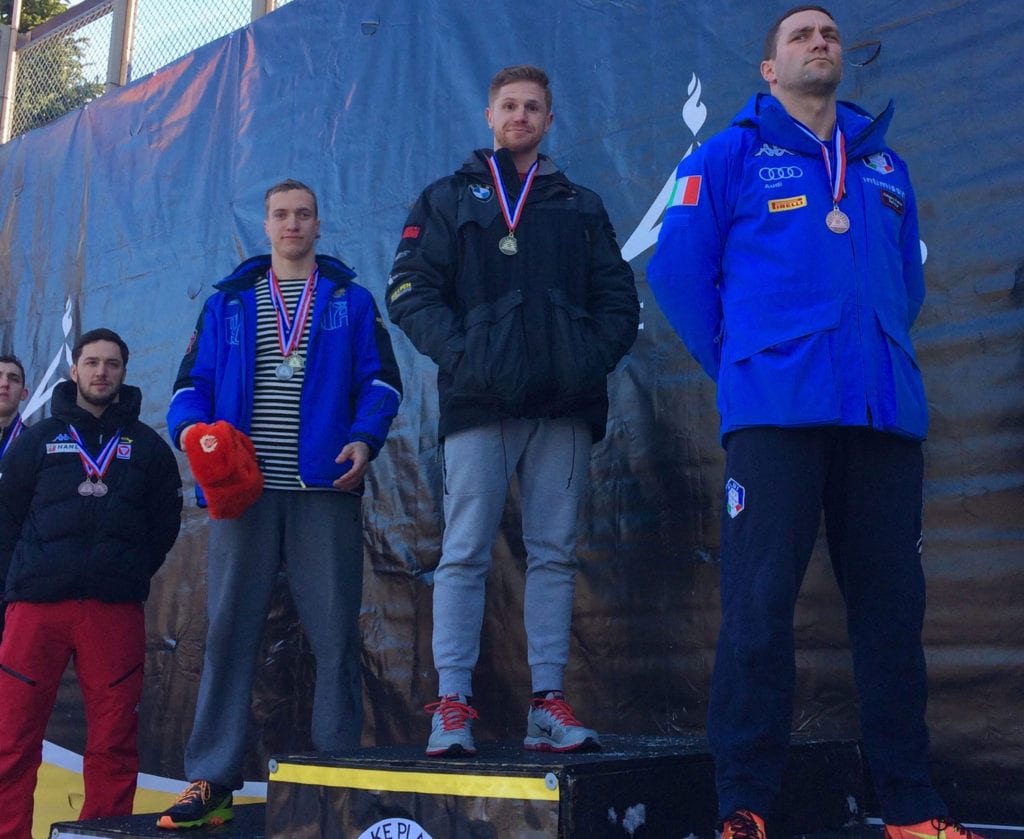
By Daniel Dunaief
This weekend, Smithtown-native John Daly’s comeback to the fast-paced world of skeleton takes an enormous step forward. He will compete against the best in the world as a member of Team USA in Koeningsee, Germany, at the World Championships.
Daly decided near the beginning of the sliding season to attempt a comeback from a sport that had been a staple of his life from 2001 until 2014.
Just to get back to this point, Daly had to earn enough points in the junior circuit to qualify. He set a goal of collecting medals and earning points. He scored three golds and a silver in North American Cup races and then topped that off with a gold and a silver in the Intercontinental Cup in Lake Placid.
Mission accomplished, so far. If he wins a medal either in Germany or in another race the next week in South Korea, the site of the 2018 Winter Olympics, Daly will continue his ascent toward claiming a spot on his third Olympic team.
Just six months ago, however, a return to a sport he left in disappointment after a difficult ending in 2014 in Sochi, Russia, wasn’t at the top of his mind.

When he was going out on dates in Washington, D.C., where he got a job in medical sales for Smith & Nephew, he had a hard time answering questions about what he was passionate about outside of work.
“Nothing got my gears going,” he recalled. “That was when I was like, ‘Maybe I do miss it.’”
At first, Daly, who is now 31, dipped his toe in the water, driving up to his home track of Lake Placid and doing a few trial runs before other sliders raced.
“I came back and I felt like I never left,” Daly said. When he asked himself what was holding him back, he didn’t have a good answer.
Getting back into shape and training required extensive driving, as Daly regularly made a nine-hour trek from Washington up to Lake Placid, home of the 1980 Miracle on Ice U.S. Men’s Hockey Team. He was grateful to his family for supporting him and to his bosses at Smith & Nephew.
During those long drives in the car, he listened to music, made phone calls with his Bluetooth and tried to stretch out. Coming back, he knew the level of effort he needed to achieve to be successful.
“No matter what, every week, I had to be faster and stronger,” he told himself. “You have to know the other guys are doing it.”
While he’s found his groove, the return to the sport hasn’t been a picnic.
“Age has kicked in,” he laughed. He takes ice baths to ease the body aches. Those, he said, can be miserable, particularly on his ankles and toes.
Daly’s parents, James and Bennarda, are happy to see their son return to the sport on his terms. In 2014, Daly was in contention for a medal at the Olympics in Sochi. At the start of his final heat, his sled popped out of the ice grooves, robbing him of precious time he couldn’t possibly make up, turning the final run into one of the most emotionally draining trips of his life.
After the Olympics, he retired, leaving the international sports stage.
“The last time you compete in the Olympics should be your best part of the Games. No matter what, if you win, lose or draw, you want to take in that last run. This is it, this is forever.”
— John Daly
“His world came crashing down,” Jesse Lichtenberg, Daly’s agent at BDA Sports Management said. Lichtenberg said Daly packed everything up in Lake Placid, put it in a box and threw it in the trunk of his car.
However, Lichtenberg and Daly’s family suspected this wasn’t the last chapter in Daly’s sliding career.
Indeed, Daly’s father, who is a retired EMS worker for the New York City Fire Department, continued to be a racing official for USA Bobsled and Skeleton Federation.
He thought, “Let me wait a couple of years, in case John has second thoughts,” the elder Daly said. “I’m glad I did. It’s so great to officiate a match that my son is in.”
Indeed, when Daly recently won a gold medal, his father got to put the award around his son’s neck.
His father believes Daly benefited from his time away from the sport, especially because it gave him some balance in his life.
“He needed to know he could go out and make a living after skeleton,” he said.
Now that his son is back on the track, he watches and he said his “heart starts to beat faster” as his son waits for a green light that signals the beginning of a race in which he runs for about five seconds before diving, headfirst, onto a sled he steers at over 80 miles an hour around curved, icy tracks.
Bennarda Daly, meanwhile, said she’s “excited and a little anxious” at the same time. “When he returned from Russia, he was different,” she said. “It wasn’t because he didn’t win.” Popping out of the groove kept him from “getting closure.”
Daly’s mom said she noticed that he hadn’t talked about sliding for the last few years, which she said was “odd” for him. “It was like it never happened. He had to close that off.”
Bennarda Daly, who is a nurse, said she doesn’t need her son to win a medal at the World Championships or at the Olympics.
“If he comes out happy and feels like it went well, I’ll be ecstatic,” she said.
As for Daly, he knows, even if he makes the Olympics next year, that he wants to walk away on his own terms.
“The last time you compete in the Olympics should be your best part of the Games,” he said. “No matter what, if you win, lose or draw, you want to take in that last run. This is it, this is forever.”



